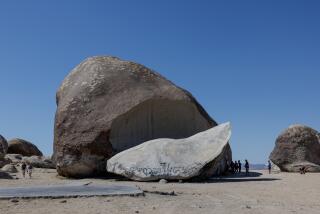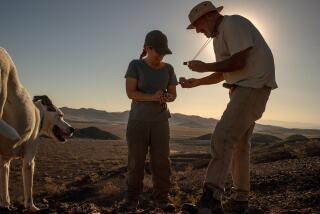Taking Gmund’s Gargantuan Rocks for Granite
- Share via
GMUND, Austria — For a different kind of outdoor rock festival, one that is as ancient as its undulating hills, come to Gmund, where you’ll swing to a more rigid kind of tune.
In one of Europe’s magic nature parks in Austria’s Upper Waldviertel region, about 70 miles northwest of Vienna, tourists try their darndest to sway gargantuan rocks for the fun of it. Here it is safe to “tilt.”
Called the Blockheide, these granite monoliths--with intriguing names such as the Devil’s Bed, the Mushroom, the Goblins, the Devil’s Loaf of Bread and the Wobbling Stones--have both a historic and a legendary past. They are real and guaranteed to make you freeze in awe, but not petrify.
Takes Two to Wobble
Granted, it does take two or more strong-armed visitors to wobble the Wobbling Stones (Wackelsteine), even if it’s just half an inch or so. But because you are never alone in this neck of the woods, help is always nigh as the cameras click to prove you’re giving it a good old college try and push.
A mere 300 yards away from the Czechoslovak border, these giant stone blocks have been lying around here for 400 million years. At that time, the earth’s interior was wildly agitated to the point that the fiery magma spewed out these massive rocks, not to be confused with drift blocks that are the products of glacial flows in Nordic countries.
Upon entering the park--called the Naturpark Gmund-Eibenstein--head for the 56-foot Lookout Tower from which you’ll swivel 360 degrees for a view overlooking the city of Gmund and the whole Gmunder basin. You’ll see the charming toy hamlets, plus the neighboring town of Ceske Velenice, formerly a part of Gmund, but Czech territory since 1920.
At the base of the tower, where there are shaded picnic tables, benches, a kiddie playground and a modest snack bar, you’ll find the information center that provides maps and foot-tour brochures.
Three paths, marked with dots, dashes and triangles, will guide you from start to finish, according to how much time you decide to devote to the nature walk routes. The dots mean three hours, dashes two hours, triangles one hour. But with your easy-to-follow map, no matter which trail you choose, you can easily include or exclude one or more of the rocky figures by detouring off the track briefly at common forks in pathways.
More than 100,000 visitors come to Gmund-Eibenstein every year. The park became a nature preserve more than 20 years ago through the efforts of Austrian sculptor-artist Carl Hermann, who decided that the industrial plundering of these granite monoliths for more than a century had to stop.
Masses of stones had been pillaged from the Waldviertel to build such things as the Franz-Josephs Railroad, tunnels, locks and Danube bridges (700 train cars full of rocks were used for the Cernavoda Bridge in Romania). One super-extraordinary natural monument, the so-called Lutheran Church, a boulder that measured 85,849 cubic feet, was sacrificed to the chopping block and lugged off to Vienna to build the Salztor Bridge.
Rich in animal life, the heath-like area is also dotted with lakes and ponds and birds like the song thrush, the robin redbreast, wild geese and storks. As for the local folk giving the stony forms a fairy-tale background with matching names, imaginations have run as wild as the fauna and flora. There are even some tall-story anecdotes, too.
Don’t miss the Devil’s Bed, so-called when the townspeople foiled a plan by the devil to destroy their souls; they put bouncy-lively fleas into Lucifer’s stolen feather blanket, who then in a rage ordered it to turn into stone.
Then there are the Christophorus Stone (whose backbone shows depressions made by the footprints of saints), the Fox, the Grill, the Sleeping Whale and, of course, the most famous ones, the Wobbling Stones.
There are three wobblers, the biggest one an intricately intertwined, elongated giant of a boulder sitting on its underpinned slabs of rock in such a way that the stone can be teetered. Rocking the rock is the name of the game. The trio are separated far from each other, so look for the numbers I, II and III on the map.
Somewhat in the center of the park is the Open-Air Geological Museum (Freilichtmuseum), where you’ll be able to identify all the varied minerals and rocks of the region. Also a large stone sundial (carved by sculptor Hermann) that shows both the time and the north-south directions on the 15th Meridian east of Greenwich.
The wobbly giants of Gmund should be on every traveler’s list, sooner or later. So leave no stone unturned to get here.
More to Read
Sign up for The Wild
We’ll help you find the best places to hike, bike and run, as well as the perfect silent spots for meditation and yoga.
You may occasionally receive promotional content from the Los Angeles Times.






